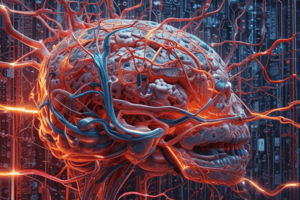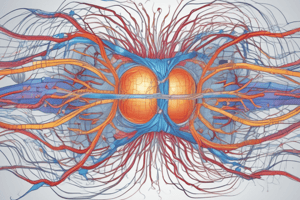Podcast
Questions and Answers
What is the technique that involves impaling a single neuron with an intracellular microelectrode and injecting it with an intracellular dye?
What is the technique that involves impaling a single neuron with an intracellular microelectrode and injecting it with an intracellular dye?
Intracellular dye injection
Which of the following is a light-gated cation channel obtained from green algae, Chlamydomonas?
Which of the following is a light-gated cation channel obtained from green algae, Chlamydomonas?
- Halorhodopsin (Halo-3)
- Channelrhodopsins (Ch1) (correct)
- Optogenetics
- Archaerhodopsin (Arch)
Exposure of Lucifer Yellow to blue/UV light results in cell death by photoinactivation.
Exposure of Lucifer Yellow to blue/UV light results in cell death by photoinactivation.
True (A)
What is the principle of Dynamic Polarization?
What is the principle of Dynamic Polarization?
Which types of neurons synapse onto muscle or gland tissue?
Which types of neurons synapse onto muscle or gland tissue?
A _____ potential is a graded change in membrane potential that varies continuously in amplitude with stimulus strength.
A _____ potential is a graded change in membrane potential that varies continuously in amplitude with stimulus strength.
Depolarization is an increase in the inside negativity of a neuron.
Depolarization is an increase in the inside negativity of a neuron.
Match the neuron types with their descriptions:
Match the neuron types with their descriptions:
Flashcards are hidden until you start studying
Study Notes
Neurons and Electrical Signaling
Membrane Types and Electrical Signaling
- Neurons have two main types of membrane: passive and active
- Passive membranes have a constant electrical potential, while active membranes have a dynamic electrical potential that can change in response to stimuli
- Examples of active membranes include "endogenous slow potentials" and "burster" neurons, which can generate repetitive action potentials
The Principle of Dynamic Polarization
- Information flows in a predictable and consistent direction within a nerve cell
- Information flow begins at the receiving (input) sites on the dendrites and soma, and ends at the trigger zone at the axon hillock (initial segment)
- At the axon hillock, the action potential is initiated and propagated unidirectionally along the axon to the presynaptic transmitter-release sites at the axon terminal
Types of Neurons
- Based on morphology:
- Multipolar neurons (e.g. turtle spinal motor neurons)
- Unipolar neurons (e.g. crayfish swimmeret motor neurons)
- Based on function and inputs/outputs:
- Motor neurons (efferents, effector cells)
- Synapse onto muscle or gland tissue
- In vertebrates, all motor neurons are excitatory
- Sensory neurons (afferents)
- Transduce sensory information
- Examples: heat, cold, light, mechanical pressure or stretch, chemical energy
- Neuroendocrine cells
- Release neurohormones into the circulation
- Interneurons
- Are both postsynaptic and presynaptic to other neurons
- Can be either local- or projection-type interneurons
- Motor neurons (efferents, effector cells)
Signal Transduction
- Local graded potentials:
- Graded changes in membrane potential that vary continuously in amplitude with stimulus strength
- Decay exponentially over distance
- Action potentials:
- Transient, all-or-none reversal of the membrane potential produced by a regenerative inward current
- Do not decay over distance
- Signal transduction in a typical vertebrate neuron:
- Local graded potentials can depolarize the neuron, leading to the generation of action potentials
- The more a local graded potential depolarizes the neuron, the higher the action potential frequency evoked
Electrophysiology Terms
- Membrane potential (EM): voltage or electrical potential (mV) across cell membranes
- Depolarization: decrease in EM, or movement of EM in a positive direction
- Hyperpolarization: increase in EM, or movement of EM in a negative direction
- Synaptic potentials: 3 major types: chemical excitatory, chemical inhibitory, electrical
Recording Electrical Activity
- Extracellular recording:
- "Differential" extracellular recording from axons and whole nerves
- "Single-ended" extracellular recording from neuronal cell bodies
- Intracellular recording:
- Sharp electrode and whole-cell patch
- Optical recording:
- Voltage-sensitive dyes
- Calcium imaging
Visualizing Neuron Anatomy
- Golgi stain:
- Stains only an occasional neuron (about 5%) in a slice of tissue
- Enables visualization of entire nerve cells in very thick sections of brain tissue
- Intracellular dye injection:
- Enables study of both electrophysiology and morphology of single neurons
- Examples: horseradish peroxidase (HRP), cobalt, biocytin, or Lucifer Yellow
Optogenetics
- Use of light to excite or inhibit cells, usually neurons, that have been genetically modified to express light-sensitive ion channels or pumps
- Examples: channelrhodopsins (Ch1 and Ch2), halorhodopsin, and archaerhodopsin
- Enables precise control of neural activity with high spatial and temporal resolution
Studying That Suits You
Use AI to generate personalized quizzes and flashcards to suit your learning preferences.




